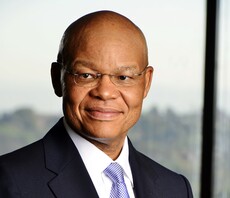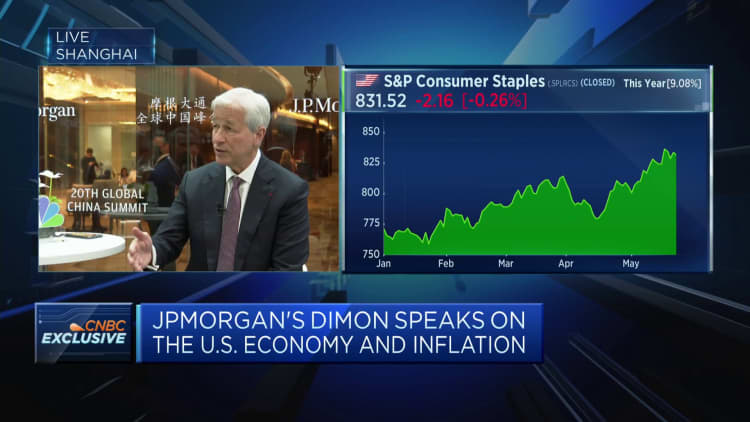In its annual results published today (23 May), the firm reported a rise in funds under management of 5.5% for its South Africa operation to £20.9bn. In the UK, Investec Wealth & Investment is now part of the Rathbones Group, following completion of the merger in September 2023. Rathbones/IW&I UK funds under management stood at £107.6bn as of the end of March 2024, up from £40.7bn a year prior. Investec owns 41.25% of Rathbones. Rathbones and Investec W&I complete merger to create £100bn wealth manager The company also revealed it has set aside a provision of £30m for the “poten…
JPMorgan CEO Jamie Dimon says U.S. could see a ‘hard landing,’ stagflation will be ‘worst outcome’
JPMorgan Chase’s chairman and CEO Jamie Dimon says the U.S. economy could see a “hard landing.” Speaking at the JPMorgan Global China Summit in Shanghai, he told CNBC that the worst outcome for the U.S. economy will be a “stagflation” scenario, where inflation continues to rise, but growth slows amid high unemployment. Dimon said interest rates could still go up “a little bit.”
JPMorgan Chase‘s chairman and CEO Jamie Dimon says the U.S. economy could see a “hard landing.”
When asked by CNBC’s Sri Jegarajah about the prospect of a hard landing, Dimon replied: “Could we actually see one? Of course, how could anyone who reads history say there’s no chance?”
The CEO was speaking at the JPMorgan Global China Summit in Shanghai.
Dimon said the worst outcome for the U.S. economy will be a “stagflation” scenario, where inflation continues to rise, but growth slows amid high unemployment.
“I look at the range of outcomes and again, the worst outcome for all of us is what you call stagflation, higher rates, recession. That means corporate profits will go down and we’ll get through all of that. I mean, the world has survived that but I just think the odds have been higher than other people think.”
However, he said that “the consumer is still in good shape” — even if the economy slips into recession.
He pointed to the unemployment rate, which has been below 4% for about two years, adding that wages, home prices and stock prices have been going up.
JPMorgan Chase & Co CEO Jamie Dimon arrives for a Senate Banking, Housing, and Urban Affairs Committee hearing on Capitol Hill September 22, 2022 in Washington, DC. Drew Angerer | Getty Images
That said, Dimon pointed out that consumer confidence levels are low. “It seems to be mostly because of inflation …The extra money from Covid has been coming down. It’s still there, you know, at the bottom 50% it’s kind of gone. So it’s I’m gonna call it normal, not bad.”
Minutes from the Fed’s May meeting released Wednesday showed that policymakers have grown more concerned about inflation, with members of the Federal Open Market Committee indicating they lacked confidence to ease monetary policy and cut rates.
Timing of Fed
CNBC
Partner Insight: High yield fundamentals
Elevated yields and rising coupons look attractive, but credit spreads are relatively tight. This environment warrants both caution and optimism. Thomas Hanson, Head of Europe High Yield at Aegon Asset Management, discusses what we should expect in 2024 for this market.
He also touches on how high yield companies are holding up in the current environment and what he thinks will be the key performance drivers for the rest of the year.
Recorded March 2024.
For Professional Clients only and not to be distributed to or relied upon by retail clients.
The principal risk of this service is the loss of capital. Please note that other risks will be present.
Opinions and/or example trades/securities represent our understanding of markets both current and historical and are used to promote Aegon Asset Management’s investment management capabilities: they are not investment recommendations, research or advice. Sources used are deemed reliable by Aegon Asset Management at the time of writing. Please note that this marketing is not prepared in accordance with legal requirements designed to promote the independence of investment research, and is not subject to any prohibition on dealing by Aegon Asset Management or its employees ahead of its publication.
Aegon Asset Management UK plc is authorised and regulated by the Financial Conduct Authority.
AdTrax: 5251239.15. Exp Date: 31 May 2025
Wall Street feasts on unlimited breadsticks and endless shrimp
Standard DigitalWeekend Print + Standard Digital
wasnow $85 per month
Billed Quarterly at $199. Complete digital access plus the FT newspaper delivered Monday-Saturday.
What’s included
Global news & analysisExpert opinionFT App on Android & iOSFT Edit appFirstFT: the day’s biggest stories20+ curated newslettersFollow topics & set alerts with myFTFT Videos & Podcasts20 monthly gift articles to shareLex: FT’s flagship investment column15+ Premium newsletters by leading expertsFT Digital Edition: our digitised print editionWeekday Print EditionFT WeekendFT Digital EditionGlobal news & analysisExpert opinionSpecial featuresExclusive FT analysisFT Digital EditionGlobal news & analysisExpert opinionSpecial featuresExclusive FT analysisGlobal news & analysisExpert opinionFT App on Android & iOSFT Edit appFirstFT: the day’s biggest stories20+ curated newslettersFollow topics & set alerts with myFTFT Videos & Podcasts10 monthly gift articles to shareGlobal news & analysisExpert opinionFT App on Android & iOSFT Edit appFirstFT: the day’s biggest stories20+ curated newslettersFollow topics & set alerts with myFTFT Videos & Podcasts20 monthly gift articles to shareLex: FT’s flagship investment column15+ Premium newsletters by leading expertsFT Digital Edition: our digitised print editionEverything in PrintWeekday Print EditionFT WeekendFT Digital EditionGlobal news & analysisExpert opinionSpecial featuresExclusive FT analysisPlusEverything in Premium DigitalEverything in Standard DigitalGlobal news & analysisExpert opinionSpecial featuresFirstFT newsletterVideos & PodcastsFT App on Android & iOSFT Edit app10 gift articles per monthExclusive FT analysisPremium newslettersFT Digital Edition10 additional gift articles per monthMake and share highlightsFT WorkspaceMarkets data widgetSubscription ManagerWorkflow integrationsOccasional readers go freeVolume discountFT Weekend Print deliveryPlusEverything in Standard DigitalFT Weekend Print deliveryPlusEverything in Premium Digital
Partner Insight: Let’s get real (about interest rates)
As I was driving home recently, I called Charles Shriver. We were talking about this Special Topic when he said something quite clever. It perfectly captured how to think about interest rates in the future.
Before I tell you what he said, let me provide some background:
Charles is a portfolio manager and cochair of the Asset Allocation Committee (AAC). We work together on all of our AAC Special Topics. He’s a fantastic investor, collaborator, and sounding board.
Prior to our conversation, Charles and I had asked Cesare Buiatti, senior quantitative investment analyst, to backfill the history of real interest rates—in other words, interest rates with inflation stripped out—in the United States by historical regime.
Cesare estimated the average real rate during each of the following regimes:
1. Postwar Boom (1955–1969)1
This era of prosperity had the strongest economic growth and the lowest unemployment of our four regimes. Inflation was also low, in the 2% range. Automation technologies and a broadening labour force that included more women, minority groups, immigrants, and globalization drove significant productivity gains.
2. Stagflation (1970–1981)
During the Stagflation regime, inflation spiked due to supply shocks, even when demand was weak because of economic stagnation. Inflation was high and often unanchored—in other words, consumers did not expect it to be temporary. Growth in gross domestic product (GDP) was low and unstable.
3. Old Normal (1982–2007)
The steady decline in interest rates was the defining feature of this era. Economic growth and inflation were “normal,” at about 3% each. Capital markets outperformed the economy due to rising valuations and cheap leverage.
4. New Normal (2008–2019)
After the global financial crisis (GFC), we entered an era of extremely accommodative central bank policy. In the New Normal, the economy got stuck in neutral, with low rates, low growth, and low inflation. This regime ended with the coronavirus pandemic.
It’s difficult to define the current regime as we unwind pandemic distortions.
What did Charles say?
As I was white-knuckling the four-lane transition on Light Street to make a right on Conway, with my head turned toward the car’s blind spot, I asked Charles what Cesare’s results looked like.
His answer, like a TV jingle or a Taylor Swift song, has been an earworm stuck in my brain since this conversation:
“The New Normal was abnormal.”
It was indeed. The table below shows the average real rate by regime. To estimate the
Most of us have too much in bonds
Standard DigitalWeekend Print + Standard Digital
wasnow $75 per month
Complete digital access to quality FT journalism with expert analysis from industry leaders. Pay a year upfront and save 20%.
What’s included
Global news & analysisExpert opinionFT App on Android & iOSFT Edit appFirstFT: the day’s biggest stories20+ curated newslettersFollow topics & set alerts with myFTFT Videos & Podcasts20 monthly gift articles to shareLex: FT’s flagship investment column15+ Premium newsletters by leading expertsFT Digital Edition: our digitised print editionWeekday Print EditionFT WeekendFT Digital EditionGlobal news & analysisExpert opinionSpecial featuresExclusive FT analysisFT Digital EditionGlobal news & analysisExpert opinionSpecial featuresExclusive FT analysisGlobal news & analysisExpert opinionFT App on Android & iOSFT Edit appFirstFT: the day’s biggest stories20+ curated newslettersFollow topics & set alerts with myFTFT Videos & Podcasts10 monthly gift articles to shareGlobal news & analysisExpert opinionFT App on Android & iOSFT Edit appFirstFT: the day’s biggest stories20+ curated newslettersFollow topics & set alerts with myFTFT Videos & Podcasts20 monthly gift articles to shareLex: FT’s flagship investment column15+ Premium newsletters by leading expertsFT Digital Edition: our digitised print editionEverything in PrintWeekday Print EditionFT WeekendFT Digital EditionGlobal news & analysisExpert opinionSpecial featuresExclusive FT analysisPlusEverything in Premium DigitalEverything in Standard DigitalGlobal news & analysisExpert opinionSpecial featuresFirstFT newsletterVideos & PodcastsFT App on Android & iOSFT Edit app10 gift articles per monthExclusive FT analysisPremium newslettersFT Digital Edition10 additional gift articles per monthMake and share highlightsFT WorkspaceMarkets data widgetSubscription ManagerWorkflow integrationsOccasional readers go freeVolume discountFT Weekend Print deliveryPlusEverything in Standard DigitalFT Weekend Print deliveryPlusEverything in Premium Digital
Trump taps Texas oil tycoons in bid to close cash gap with Biden
Standard DigitalWeekend Print + Standard Digital
wasnow $75 per month
Complete digital access to quality FT journalism with expert analysis from industry leaders. Pay a year upfront and save 20%.
What’s included
Global news & analysisExpert opinionFT App on Android & iOSFT Edit appFirstFT: the day’s biggest stories20+ curated newslettersFollow topics & set alerts with myFTFT Videos & Podcasts20 monthly gift articles to shareLex: FT’s flagship investment column15+ Premium newsletters by leading expertsFT Digital Edition: our digitised print editionWeekday Print EditionFT WeekendFT Digital EditionGlobal news & analysisExpert opinionSpecial featuresExclusive FT analysisFT Digital EditionGlobal news & analysisExpert opinionSpecial featuresExclusive FT analysisGlobal news & analysisExpert opinionFT App on Android & iOSFT Edit appFirstFT: the day’s biggest stories20+ curated newslettersFollow topics & set alerts with myFTFT Videos & Podcasts10 monthly gift articles to shareGlobal news & analysisExpert opinionFT App on Android & iOSFT Edit appFirstFT: the day’s biggest stories20+ curated newslettersFollow topics & set alerts with myFTFT Videos & Podcasts20 monthly gift articles to shareLex: FT’s flagship investment column15+ Premium newsletters by leading expertsFT Digital Edition: our digitised print editionEverything in PrintWeekday Print EditionFT WeekendFT Digital EditionGlobal news & analysisExpert opinionSpecial featuresExclusive FT analysisPlusEverything in Premium DigitalEverything in Standard DigitalGlobal news & analysisExpert opinionSpecial featuresFirstFT newsletterVideos & PodcastsFT App on Android & iOSFT Edit app10 gift articles per monthExclusive FT analysisPremium newslettersFT Digital Edition10 additional gift articles per monthMake and share highlightsFT WorkspaceMarkets data widgetSubscription ManagerWorkflow integrationsOccasional readers go freeVolume discountFT Weekend Print deliveryPlusEverything in Standard DigitalFT Weekend Print deliveryPlusEverything in Premium Digital
ETFs shift from ‘core’ to ‘satellite’ in portfolios
Stay informed with free updates
Simply sign up to the Exchange traded funds myFT Digest — delivered directly to your inbox.
Latest news on ETFs
Visit our ETF Hub to find out more and to explore our in-depth data and comparison tools
Exchange traded funds are increasingly vehicles of choice for active strategies and for tactical short-term use, a new study reveals, underlining how much has changed from their buy-and-hold, broad market historical origins.
Actively managed ETFs that guarantee protection against losses, leveraged or inverse strategies that reset daily and cryptocurrency investments topped the list of ETF strategies that appealed most to investors in the US, Europe, China, Hong Kong and Taiwan, according to the latest Brown Brothers Harriman survey of more than 300 institutional investors globally.
While about half of survey respondents said they used ETFs as “satellites” in their portfolios, only 40 per cent globally and 33 per cent in the US said they used ETFs as “core” exposure — a surprising result given how widespread the use passive index-based ETFs had become, said Tim Huver, managing director on BBH’s ETF servicing team.
“We do see this as a shift in terms of investor demand towards a greater offering of a variety products that may be used in very specific or precise ways, as opposed to broad-based beta in the past,” Huver told the Financial Times.
Active ETFs make up about 7 per cent of the $8.6tn US ETF market but have pulled in about 16 per cent of net inflows over the past three years, according to data from Morningstar Direct. They’ve garnered more than $78bn in flows since January, more than double the $31.5bn they attracted in the first four months of 2023.
Passive ETFs continue to dominate inflows, pulling in more than $78bn in April alone and more than $1.6tn since May 2021, according to Morningstar. However, active ETFs grabbed more flows than their passive counterparts in April, the first month that has happened since August last year.
Buffered ETFs, which cap falls in value in return for limits on upside, have proven particularly popular with investors. And ETFs that use derivatives to offer higher leverage or inverse performance have carved out a niche among traders and retail investors.
Cryptocurrency ETFs remain a topic of high interest globally for investors. Regulators in the US and Hong Kong approved spot bitcoin ETFs in January and April, respectively, while European investors can
US to seek break-up of Live Nation in lawsuit
Standard DigitalWeekend Print + Standard Digital
wasnow $75 per month
Complete digital access to quality FT journalism with expert analysis from industry leaders. Pay a year upfront and save 20%.
What’s included
Global news & analysisExpert opinionFT App on Android & iOSFT Edit appFirstFT: the day’s biggest stories20+ curated newslettersFollow topics & set alerts with myFTFT Videos & Podcasts20 monthly gift articles to shareLex: FT’s flagship investment column15+ Premium newsletters by leading expertsFT Digital Edition: our digitised print editionWeekday Print EditionFT WeekendFT Digital EditionGlobal news & analysisExpert opinionSpecial featuresExclusive FT analysisFT Digital EditionGlobal news & analysisExpert opinionSpecial featuresExclusive FT analysisGlobal news & analysisExpert opinionFT App on Android & iOSFT Edit appFirstFT: the day’s biggest stories20+ curated newslettersFollow topics & set alerts with myFTFT Videos & Podcasts10 monthly gift articles to shareGlobal news & analysisExpert opinionFT App on Android & iOSFT Edit appFirstFT: the day’s biggest stories20+ curated newslettersFollow topics & set alerts with myFTFT Videos & Podcasts20 monthly gift articles to shareLex: FT’s flagship investment column15+ Premium newsletters by leading expertsFT Digital Edition: our digitised print editionEverything in PrintWeekday Print EditionFT WeekendFT Digital EditionGlobal news & analysisExpert opinionSpecial featuresExclusive FT analysisPlusEverything in Premium DigitalEverything in Standard DigitalGlobal news & analysisExpert opinionSpecial featuresFirstFT newsletterVideos & PodcastsFT App on Android & iOSFT Edit app10 gift articles per monthExclusive FT analysisPremium newslettersFT Digital Edition10 additional gift articles per monthMake and share highlightsFT WorkspaceMarkets data widgetSubscription ManagerWorkflow integrationsOccasional readers go freeVolume discountFT Weekend Print deliveryPlusEverything in Standard DigitalFT Weekend Print deliveryPlusEverything in Premium Digital



